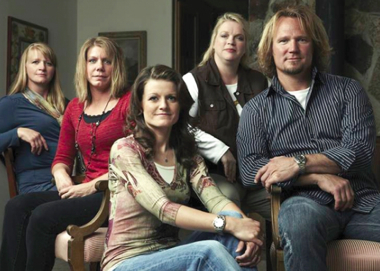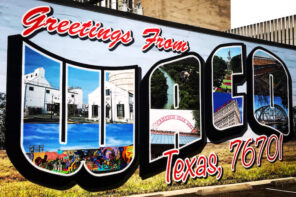Every other year when I was growing up, my family attend a reunion for all the descendants of all seven wives of one of my great-great-grandfathers. Born in Bavaria in 1825, John, who anglicized his name when he joined the Mormon church and moved to North America, died in Sonora, Mexico in 1899, having moved there so he could practice polygamy unmolested by the US government. I always knew that polygamy was part of my legacy as a Latter-day Saint, even if I never knew exactly what to think of it.
Currently the most notorious aspect of that legacy is the Fundamentalist Church of Jesus Christ of Latter-Day Saints, otherwise known as the FLDS, the sect run by Warren Jeffs, who’s serving a life sentence in Texas for sexual assault of a child. Among other things, Jeffs’ followers are known for their secrecy, their old-fashioned clothing, their avoidance of the media, and horrifying stories of pubescent girls married off to and impregnated by men old enough to be their grandfathers.
Thanks to shows like HBO’s Big Love or Polygamy, U.S.A, many Americans now know that not all polygamists wear funny clothes, fear technology and publicity, or marry off little girls to old men. Instead, just like any number of secular polyamorists, many polygamists can and do pass for conventional Americans—and have argued that they deserve the right to be treated as such.
Friday evening, a federal judge announced that he agreed with them. Judge Clark Waddoups of the United States District Court in Utah issued a 91-page decision in a lawsuit filed by Kody Brown, who, with his four wives and numerous children, stars in TLC’s reality show Sister Wives. Judge Waddoups ruled that although the state has the right to deny people more than one valid marriage license at a time, Utah’s anti-cohabitation laws violate the Browns’ First Amendment right to freedom of religion and elements of constitutional due process.
*
The situation involves a stunning role reversal. Early Latter-day Saints, including my ancestors, claimed that practicing polygamy was their religious right under the constitution. Informed otherwise by the United States, they walked over 1,200 miles after the assassination of Joseph Smith in 1844, from Nauvoo, Illinois, to Salt Lake City, Utah, to secure that and other freedoms—only to exchange them for Utah’s statehood 50 years later.
The process by which the LDS Church went from affirming polygamy as one of its most important principles to renouncing the practice and excommunicating any Mormon who engages in it is told succinctly and compellingly in The Politics of American Religious Identity: The Seating of Senator Reed Smoot, Mormon Apostle by Kathleen Flake.
Briefly put, the Edmunds-Tucker Act of 1887 disincorporated the church and gave the federal government the power to seize the church’s assets. To save those assets, and to aid Utah in its attempts to become a state, Wilford Woodruff, fourth president of the church, issued a Manifesto in 1890 declaring that thenceforth, Latter-day Saints would no longer enter into polygamous marriages. When Utah became a state in 1896, explicit bans on polygamy were included in its state constitution, at the behest of the same federal government that now says such bans violate citizens’ fundamental rights.
The real catch for the church is that although it renounced the practice of polygamy, it never renounced the doctrine: Section 132 of the Doctrine and Covenants, which lays out the “new and everlasting covenant,” or plural marriage, is still canonized as official LDS scripture. Verses 62 and 63 state:
62 And if [a man] have ten virgins given unto him by this law, he cannot commit adultery, for they belong to him, and they are given unto him; therefore is he justified.
63 But if one or either of the ten virgins, after she is espoused, shall be with another man, she has committed adultery, and shall be destroyed; for they are given unto him to multiply and replenish the earth.
As a mainstream Mormon teen in the 1970s and 80s, I was regularly told that all Latter-day Saints would be required to practice polygamy in the hereafter, whether we liked it or not. (Most of the young women did not like the idea, but we were assured we’d learn to like it, given that it was how things worked in heaven, and heaven was perfect.) Mormon fundamentalists therefore have good reason for arguing that renouncing the practice of polygamy was a political calculation that the LDS church never would have made had it remained true to its principles.
Given the LDS church’s desire to influence the political and social mainstream, there’s little chance that it will once again sanction polygamy. It’s also unlikely that it will move very quickly to renounce the controversial doctrine, since doing so would be a tacit admission that Joseph Smith was guided by something other than divine inspiration in introducing it.
While Friday’s decision might make life easier for polygamists like Brown et ux, it’s unlikely to do much to help Jeffs or his followers. As previously mentioned, the state still has the right to deny multiple marriage licenses, and issues of coercion and consent still come into play when underage girls are wed to older men, as is common on Jeffs’ sect. And as another TLC offering, Breaking the Faith, makes clear, opposition to polygamy or disloyalty to “Uncle Warren” are not always the reasons that people leave the FLDS community—and leave they do.
Currently airing Sunday nights, Breaking the Faith follows a group of young women and men age 18 to 21 who leave ‘the Crick,” a remote polygamous community straddling the Utah-Arizona border. While most of them express some doubts about Jeffs’ leadership, those doubts often have to do with cruel, sweeping intrusions that make their day-to-day lives ridiculously hard. Ruling from prison, Jeffs still demands absolute obedience to his bizarre, capricious rules. The extensive list of things he has banned includes chocolate, dairy products, bicycles, all media except a few religious texts, any sort of celebration, and socializing of any kind.
He even banned pets: When a dog killed a small child in the community, rather than kill the guilty dog, Jeffs had every dog in the community shot. “All we do is work,” the girls say, clearly desperate for another life, even though several of them profess to still believe that Jeffs is a true prophet.
All the young people in Breaking the Faith have been not only shaped but deeply traumatized by life in the Crick, though they are too guarded to reveal much of that trauma to the camera. A much clearer account of the sort of suffering young FLDS endure can be found in Sons of Perdition.
Filmed over several years and therefore deeper and broader in its coverage than Breaking the Faith, the 2010 documentary focuses on three teenage boys: Sam, Bruce and Joe, a slender boy who loves drawing fierce monsters but has never heard of comic books. He is never so happy as when his infant brother sleeps on the floor beside him while he watches TV, a situation made possible because his mother, desperate to avoid her fourteenth pregnancy and forbidden like all women at the Crick to use birth control or deny her husband sex, finally flees Joe’s father.
Clear-eyed about the cost of leaving the Crick, Joe says, “A lot of kids think that, ‘OK, we’re leaving’”—which entails the psychological pain of condemning themselves to hell, because even though they’re leaving the community, they haven’t shed the belief system yet—“‘so we’re gonna bring a piece of hell with us.’ It’s like there’s hell in our hearts.”
*
Even for someone like me, who rejected decades ago the idea that God requires men to have multiple wives and women to submit to male authority and satisfy male sexuality in order to get into heaven, this business uncovers a bit of hell in my heart. I’m honestly glad about Friday’s ruling; I believe the Browns should have the right to constitute their family as they so choose, even if their choices are somewhat repellent to me.
But the ruling doesn’t heal the hideous wound festering on the LDS psyche—it only exposes it. Joseph Smith and Brigham Young did cruel, cruel things to their followers and their wives as they taught and practiced the doctrine of polygamy. My ancestors, admittedly clannish, self-righteous people, paid for their faults by being repeatedly evicted from their homes and being threatened with extermination on order of the governor in Missouri. The Mormon migration to Utah involved tremendous suffering, as evidenced by the hymn “All Is Well,” so-named to convince people not to despair. It promised that things would be better when the Saints reached
the place which God for us prepared,
far away, in the west,
where none shall come
to hurt or make afraid;
there the Saints will be blessed.
But the Saints did not feel safe from persecution even in the far away west, which is why LDS history is blighted by the Mountain Meadows Massacre: in 1857 Mormons attacked a wagon train traveling across southern Utah to California from an area in Arkansas where Mormon apostle Parley P. Pratt had recently been murdered.
Whether motivated by fear, retribution or greed, it was an utterly savage slaughter: about 120 unarmed men, women and children were systematically murdered, after which the smallest children were adopted, sometimes by the men they’d watched kill their parents and siblings.
As much as the LDS church wants to distance itself from the FLDS and other offshoots of Mormonism, they all share not just a history but a trauma. We don’t have to confront it together, but we all have to confront it, especially now that the courts are confronting it as well. The ruling should provide fascinating material for any reality TV show or documentary about polygamy, as people try to wrap their heads around the fact that a government that once prosecuted their ancestors for practicing polygamy now decrees that it’s a fundamental right a state can’t withhold.
That’s a plot twist only someone blessed with the gift of prophecy could have predicted when the Mormon story began on the other side of the continent almost two centuries past. I’ve never been much of a fan of Joseph Smith, but I can’t help wondering what he’d say about it.





